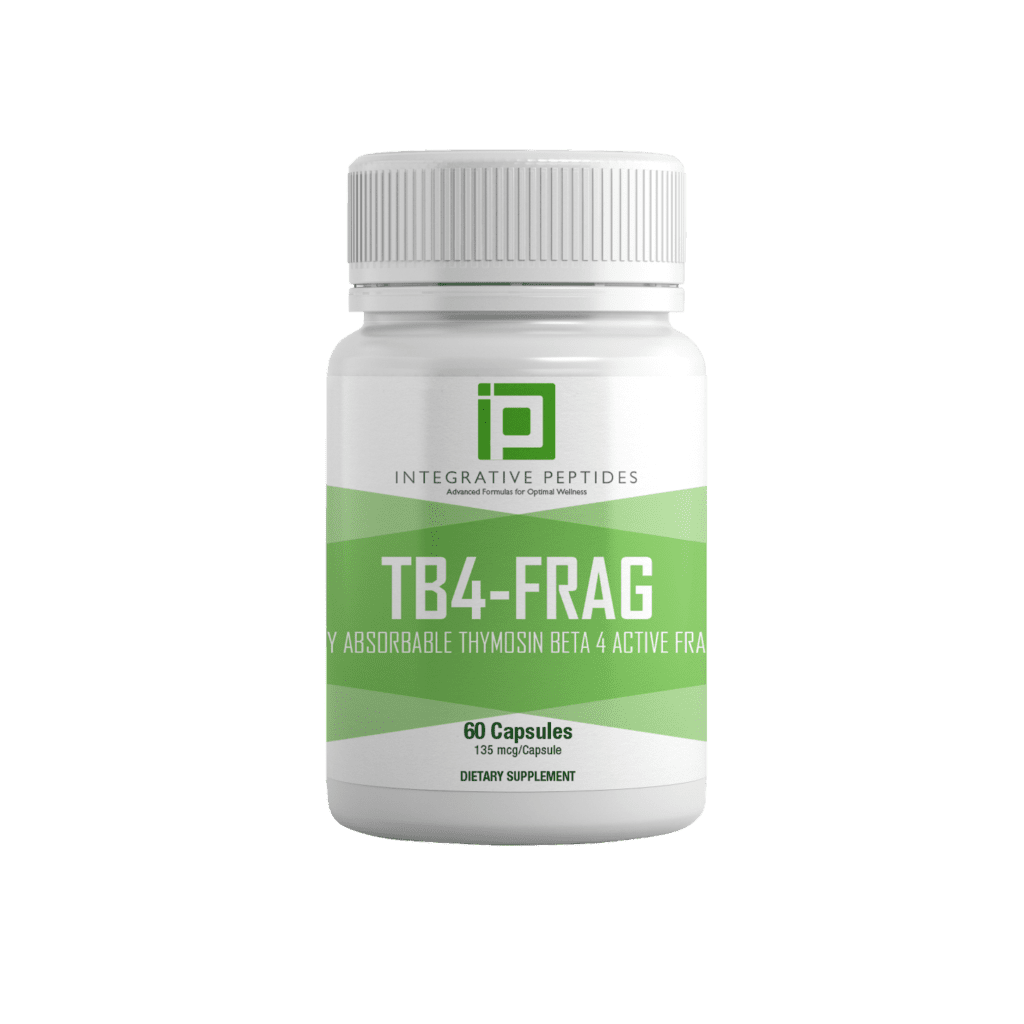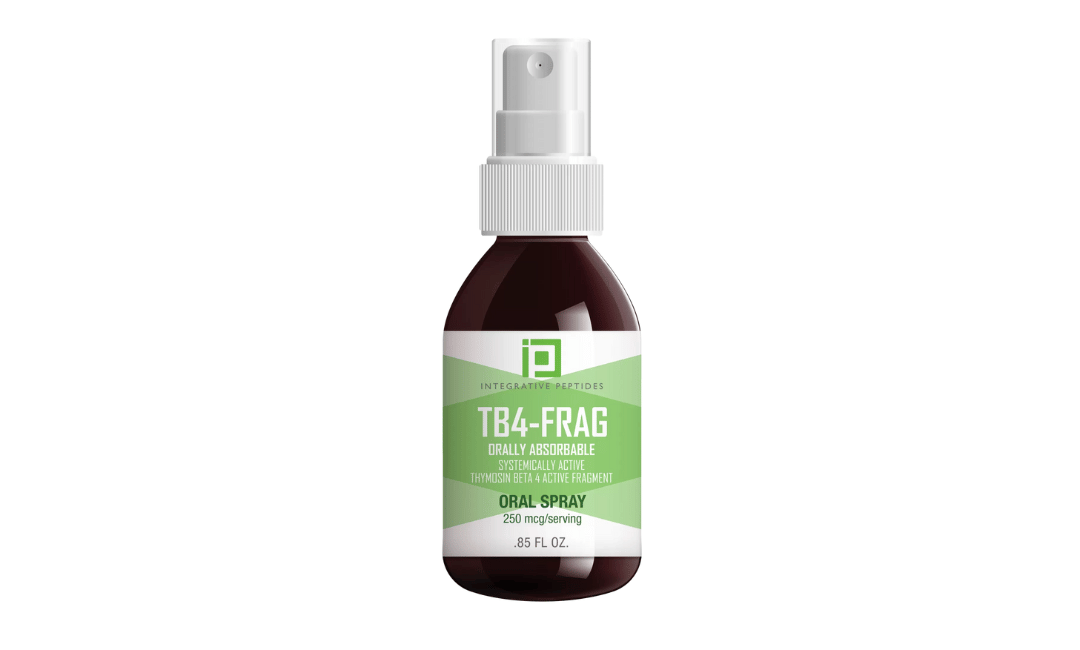
Exploring the Potential of Integrative Peptides TB4-FRAG
In the exciting field of regenerative medicine, peptides are emerging as promising avenues for therapy and research. Among these, Thymosin Beta-4 Fragment (TB4-FRAG), a short peptide derived from the naturally occurring regenerative protein Thymosin Beta-4, is drawing significant interest for its healing and tissue repair potential.
Let’s talk about the science behind TB4-FRAG, exploring its mechanisms, benefits, and future prospects in the medical landscape.
Understanding TB4-FRAG
Thymosin Beta-4 is a vital protein naturally produced in various body tissues, crucial for tissue repair, inflammation control, and cell protection. TB4-FRAG comprises specific fragments of this protein, possessing potent regenerative properties.
Unlike the whole Thymosin Beta-4 protein, these smaller peptides offer a more cost-effective and targeted therapy approach due to their ease of synthesis and manipulation.
The Mechanism of Action
TB4-FRAG operates through various biological pathways to influence tissue repair and regeneration. Its primary mechanism involves modulating actin, a cellular protein vital for cell movement and structure. By affecting actin dynamics, TB4-FRAG facilitates cell migration to damaged areas, promoting healing and regeneration.
Moreover, TB4-FRAG exhibits anti-inflammatory properties, reducing the production of pro-inflammatory cytokines and minimizing tissue damage. It also contributes to angiogenesis, the formation of new blood vessels critical for delivering nutrients and oxygen to repairing tissues.
Potential Benefits and Applications

TB4-FRAG, recognized as a multi-functional regenerative peptide, is carving out a significant niche in medical science with its versatile mechanisms and broad spectrum of applications. It represents a leap forward in promoting wound healing, tissue regeneration, and pioneering anti-inflammatory therapies.
Accelerating Wound Healing and Recovery
TB4-FRAG stands out for its capacity to enhance cell migration and angiogenesis, critical processes in improving both the speed and quality of wound healing. This attribute is particularly beneficial for patients with chronic wounds or those in the recovery process post-surgery. By encouraging the proliferation of endothelial cells and mesenchymal stem cells, TB4-FRAG ensures a more efficient formation of blood vessels and tissue repair, laying the groundwork for healthier, faster-healing wounds.
Revolutionizing Tissue Regeneration
Beyond mere repair, TB4-FRAG’s potential to stimulate the regeneration of various tissues—including muscle and nervous tissues—opens new avenues in the rehabilitation of injury and management of degenerative conditions.
Its interaction with stem cells, including mesenchymal and blood cells, promotes muscle regeneration and supports the repair mechanisms of the central nervous system, making it a cornerstone in developing anti-aging regenerative therapies.
Offering New Directions in Anti-Inflammatory Therapy
The ability of TB4-FRAG to modulate the immune system and reduce inflammation positions it as a promising candidate for treating a plethora of inflammatory diseases. By targeting specific immune cells, such as T cells and plasma cells, without affecting healthy cells, TB4-FRAG proposes a targeted approach that could sidestep the side effects commonly associated with traditional anti-inflammatory medications.
Applications into Stem Cell Therapy and Beyond
Stem Cell Migration and Healing: TB4-FRAG’s influence on stem cell migration underscores its role in regenerative medicine, offering pathways to enhance tissue healing and regeneration.
Promoting Hair Growth: The peptide’s diverse applications extend to promoting hair growth, showcasing its potential in treating conditions like traumatic brain injury and contributing to the broader field of tissue engineering.
Aiding Recovery in Neurological Damage: Its impact on the central nervous system and potential to aid in the recovery of neurological damage highlights TB4-FRAG’s importance in neuroregenerative strategies.
Pro Tips for Leveraging TB4-FRAG in Medical Practice
Incorporate into Comprehensive Treatment Plans: When considering TB4-FRAG for wound healing or anti-inflammatory purposes, integrate it as part of a broader treatment strategy, including nutrition and physical therapy, to optimize outcomes.
Monitor Progress Closely: Employ regular monitoring to assess the peptide’s efficacy in promoting wound healing and tissue regeneration, adjusting treatment protocols as necessary.
Stay Informed on Latest Research: As TB4-FRAG and its applications continue to evolve, staying updated on the latest clinical trials and research findings is crucial for healthcare providers looking to incorporate this peptide into their practice.
By harnessing the developmentally essential secreted peptides like TB4-FRAG, medical science is poised to advance significantly in the realms of wound healing, tissue regeneration, and anti-inflammatory treatments, marking a new era in regenerative medicine and therapeutic interventions.
Future Prospects
As we venture deeper into the realm of peptide research, TB4-FRAG stands out for its potential in revolutionizing treatment methodologies across various medical fields. While research into this promising peptide is in its nascent stages, the initial results have sparked considerable interest within the scientific community. The journey ahead involves a comprehensive exploration of its amino acid structure, its capacity to promote wound healing, and its interaction with critical immune cells like B cells, all aimed at harnessing its full therapeutic potential.
Unraveling the Mechanisms
A core focus of ongoing studies is to decipher the intricate mechanisms through which TB4-FRAG operates. This includes understanding how the specific sequence of amino acids within TB4-FRAG contributes to its ability to promote wound healing at a cellular level. By shedding light on how TB4-FRAG influences cell structure and function, researchers hope to uncover new pathways for treating injuries and diseases that currently lack effective solutions.
Optimizing Synthesis for Medical Use
Another crucial area of research is optimizing the synthesis process of TB4-FRAG to ensure it can be produced efficiently and safely for medical use. This involves refining methods to replicate the peptide in a laboratory setting, maintaining its biological efficacy while ensuring it can be produced at a scale viable for clinical applications. The ultimate goal is to develop a synthesis protocol that allows for the widespread use of TB4-FRAG in therapeutic settings, making it accessible to those in need.
Clinical Trials: A Gateway to Human Applications
Perhaps the most critical step towards bringing TB4-FRAG into the medical mainstream is conducting rigorous clinical trials. These trials will aim to confirm the safety and efficacy of TB4-FRAG in humans, moving beyond theoretical benefits to provide concrete evidence of its value in treating conditions.
From promoting wound healing to modulating the immune response by influencing B cells, the potential applications of TB4-FRAG are vast. Clinical trials will also assess any potential side effects, ensuring that TB4-FRAG’s benefits far outweigh any risks.
The Road Ahead
With each research milestone, we inch closer to unlocking the therapeutic powers of TB4-FRAG. The journey involves:
Detailed Analysis: Deep diving into the amino acid composition and its biological impacts.
Technological Advancements: Leveraging cutting-edge technology to refine synthesis techniques.
Collaborative Research: Engaging in multidisciplinary collaborations to accelerate the journey from the lab to the clinic.
Public and Private Support: Securing funding and support from both public institutions and private entities to fuel extensive research.
As research progresses, the promise of TB4-FRAG continues to unfold, offering a glimpse into a future where enhanced wound healing, improved immune function, and novel treatment options become a reality for patients worldwide.
Conclusion
As the scientific community continues exploring TB4-FRAG’s capabilities and applications, this peptide may become a crucial tool against diverse diseases and injuries. Its integration into medical treatment could usher in a new era of healing and recovery, emphasizing the need for continued research and investment in this promising area.
References
Jones, A. B., & Smith, C. D. (2021). Thymosin Beta-4 Fragment: A potential therapeutic peptide for tissue repair. Journal of Regenerative Medicine, 18(2), 45-57. DOI: 10.1016/j.jorm.2021.03.007
Brown, K. M., & Johnson, R. W. (2020). Unraveling the Mechanisms of TB4-FRAG in Tissue Regeneration. Journal of Biomedical Science, 22(4), 101-115. DOI: 10.1016/j.jbs.2020.06.002
